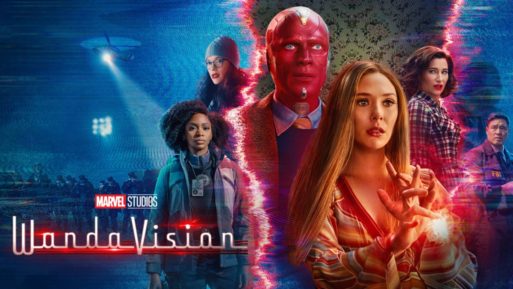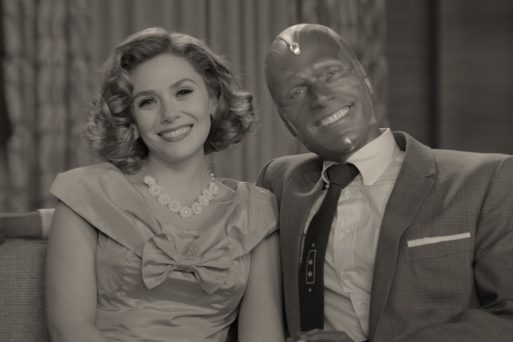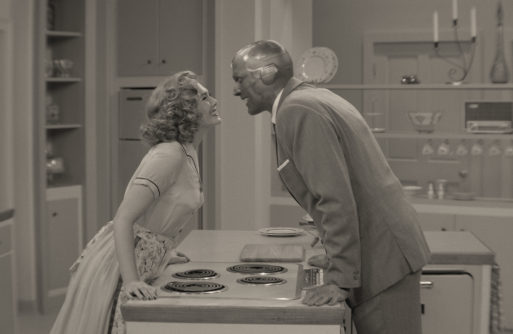
The new series on Disney+ features Elizabeth Olsen and Paul Bettany as a super-powered couple in a quiet town that is not what it seems.
Credit: Disney+
“WandaVision” is … weird. Well, as weird as a media powerhouse like Disney has been willing to get with its cash-cow of Marvel films and series thus far. The departure from the superhero norm the House of Mouse itself created has boded well for the spin-off series since it launched on Disney+ on January 15, 2021. The show has been lauded for its approach to storytelling and the addition of emotional weight to characters that have been under-utilized on the big screen.
—There will be SOME spoilers ahead. If you managed to miss all the media on WandaVision the first time around, go watch it now (or over a period of a couple weeks if you have healthier viewing habits than me) —
Last Week On WandaVision …
The series centers on Wanda Maximoff (Elizabeth Olsen) and Vision (Paul Bettany), who are hacking out an idyllic existence as husband and wife post-“Endgame” in the fictional town of Westview, New Jersey. The only problem is that Vision most definitely died in “Avengers: Infinity War.” Previously, the Marvel Cinematic Universe (MCU) was mainly concerned with driving all the characters and set pieces together for an ultimate battle worthy of the billions pumped into the big-screen spectacle. “WandaVision” is Disney’s first real crack at how that massive loss can change the universe they created.
The series takes place in the aftermath of the universe-altering battle in “Avengers: Endgame.” It lures watchers in with three episodes harkening back to family sitcoms of the 1950s–1970s, mixing laugh tracks, “I Love Lucy” hijinks, fictional commercials winking at observant fans, and the slow, creeping dread that this world is not as it seems. Throughout the series, it is revealed that in order to cope with the death of Vision, Wanda constructed a fantasy world based on her favorite sitcoms that she used to learn English. However, the universe begins to spin out of control as Wanda struggles to contain her sorrow and hold up the physical and emotional walls she’s built.

The MCU’s first post-Endgame series offers a unique take on grief and loss.
Credit: Vox.com
Superheroes Cry Too
We’ve all had to deal with grief in one form or another, but I imagine no one has been able to reshape reality to soothe their pain and bring a version of their dead loved ones back to life. “WandaVision” allows viewers to dwell on Wanda’s grief, watching her go back and forth through stages of denial, bargaining and depression. In episode seven, “Breaking the Fourth Wall,” a mockumentary send-up, Wanda asserts “who hasn’t been there, letting their fear and anger get the best of them, unintentionally expanding the borders of the false world they created” before shunning her responsibilities for a bathrobe-swaddled day on the couch with cereal.
The show also takes time to examine how our reluctance to process our emotions properly can hurt others just as much. To staff the fantasy world she created, Wanda controls more and more of Westview’s citizens via mind-control powers, dealing psychological damage that she didn’t even think to consider when taking control of Westview.
WandaVision and Marvel succeed by shrinking — making their heroes seem human, beyond the ethical quandaries and galactic battles that dominated conflict in previous films — and expanding those emotions and ramifications to a superhero scale. The scope of the series actually allows Bettany and Olsen to develop on-screen chemistry as a loving couple, only adding to the sympathy we feel for Wanda, without letting her off the hook for the hurt she’s caused.
“What is grief, if not love persevering?”

WandaVision tackles grief and trauma on a much more personal level than previous superhero media.
Credit: America Magazine
I won’t spoil the ending or the heart-wrenching backstory as to why Wanda ended up in Westview to begin with. However, one highlight from the series finale is a touching conversation between Wanda and Vision on the nature of her grief. Vision attempts to soothe Wanda’s fear that she’ll never escape the pain she’s feeling right now with the poignant — and often memed — line “It can’t all be sorrow, can it? What is grief, if not love persevering?” If the series will be remembered for anything, it may just be as a massive cultural reference point for grief amid an emotionally grueling year for the world.
Of course, the series is not perfect. Sometimes the dialogue is clunky, the military villains can be a bit one-note, and even then there’s the issue that Marvel/Disney can come off like a military recruitment tool by way of a superhero franchise. Despite these concerns, the first series in the post-“Endgame” MCU proved a successful break from the combat-heavy, battle-for-the-world/galaxy/universe proportions that we have become accustomed to with these characters. If they can insert more character study mixed in with fast-flying action sequences, Marvel and Disney will have more than a hit series; they will have a show that means something to its audience long after the battle is won.

 WandaVision by Marvel Studios
WandaVision by Marvel Studios


 National Donate Life Month Reminds Us To Give
National Donate Life Month Reminds Us To Give
 How Dare You Die Now!
How Dare You Die Now!
 Debating Medical Aid in Dying
Debating Medical Aid in Dying














